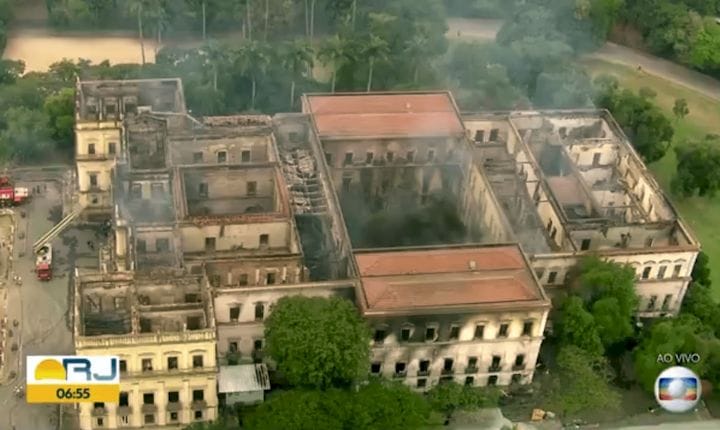![A fire at Rio de Janeiro’s 200-year-old National Museum has destroyed virtually all their collection [Source: Globo.com via The Guardian]](https://fabbaloo.com/wp-content/uploads/2020/05/image-asset_img_5eb0a8229eab4.jpg)
An unbelievable cultural catastrophe occurred in Rio de Janeiro, when the country’s national museum caught fire and destroyed all.
It’s all over the news: somehow after hours a fire ignited in the 200-year-old institution, and fire rapidly spread due to wooden construction elements and the contents.
Yes, the contents. The museum’s entire collection of twenty MILLION objects was almost completely destroyed. According to The Guardian:
“Its impressive collections included items brought to Brazil by Dom Pedro I – the Portuguese prince regent who declared the then-colony’s independence from Portugal – Egyptian and Greco-Roman artefacts, ‘Luzia’, a 12,000 year-old skeleton and the oldest in the Americas, fossils, dinosaurs, and a meteorite found in 1784. Some of the archive was stored in another building but much of the collection is believed to have been destroyed.”
Being a history enthusiast, I am shocked by this news. Literally 200 years of work by researchers, explorers, historians, scientists and the public were collected and placed at this one site.
And then it was all gone in one night.
While the museum was the de facto “owner” of the millions of artifacts, it is more true to say that they were custodians of objects holding a shared cultural history. Those artifacts represented the steps towards the current state in Brazil and elsewhere, and seeing them gives one a perspective on where everything came from, and where things may be going in the future.
The loss is incalculable, staggering and unbearably difficult to consider.
Now all that is left from this disaster are digital traces captured in notes and photographs stored elsewhere.
My question is, did the museum hold proper 3D scans of their collection, so that at least some detailed information could be recovered?
Many museums currently have 3D scanning projects underway to digitally capture their collections. Some do this for analysis, as the scans allow methods of inspection not always possible in person. They also permit others to remotely examine the 3D model, even simultaneously.
But another reason to do the scan is as insurance against just such a disaster as occurred in Rio de Janeiro.
I’m pretty sure this institution did not have 3D scans of their collection, as they were apparently under severe budget constraints to the point where the facility was under some risk. In fact, they apparently just signed a deal to upgrade the fire control system, but alas, it was too late.
Digital 3D models of artifacts are by no means a replacement. You can see (and even touch if 3D printed) the shape of the object, but you cannot, for example, analyze its DNA or perform carbon dating tests.
But it’s far better than nothing. What would you rather have: a digital 3D model or just a memory?
The lesson here is very clear: institutions charged with holding unique cultural artifacts should 3D scan their entire collections, not only as insurance against a catastrophe, but also to enable more wide distribution of their objects. This would allow more people to learn about the artifacts, their culture, themselves and each other.
Isn’t that what museums are for?
Via The Guardian











It turns out the Smithsonian has a relatively large (for museums) library of downloadable 3D models for 3D printing. We’re trying one now.